A tale of two very different Thai resorts
Compare and contrast – a beachside wellness retreat and a 22-storey hotel in the highlands.
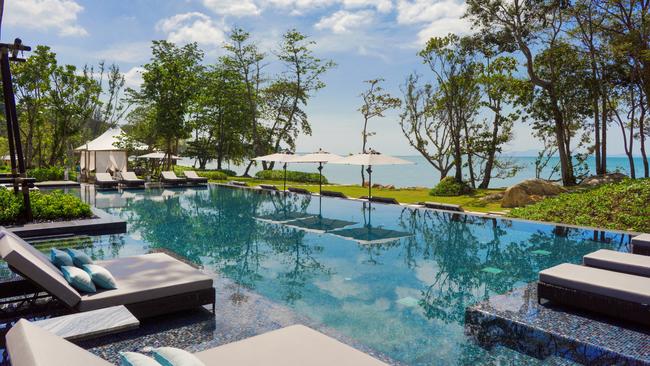
Morning yoga has never been my thing but after a sunrise session at Banyan Tree Krabi I could be converted. Ayurvedic guru Dr Subhash Shanbagh leads a “beginner’s’’ class on a rainforest-shaded deck to a soundtrack of birdsong and fantastic views over jungled islands that rise sheer from the Andaman Sea.
The doctor explains the principles of yoga – how it promotes harmony between body and mind, senses and breath – then urges me into strenuous, not-beginner’s exercises such as the contortionist pigeon pose and the statuesque tree pose (mine topples).
Then follows a bout of Tibetan fire breathing, a form of hyperventilation involving short, sharp breaths and pumping fists. It must look strange but the reward is a flooding sense of euphoria. It’s a surprisingly great start to the day.
The new-ish Banyan Tree resort opened in late 2020 beside southwest Thailand’s Phang Nga Bay, as beautiful a stretch of coastline as exists in Asia. It has only recently welcomed foreigners after the country’s strict Covid rules eased in October. Its 72 suites and villas occupy a 4ha stretch of tropical shoreline on isolated Tubkaek Beach. Dragon Crest Mountain National Park lies just beyond the resort gates; it’s a 4km hike to the summit for rousing, 180-degree panoramas of rainforest and archipelago.
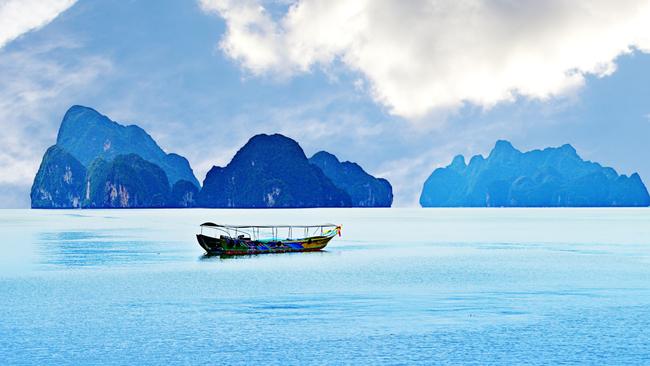
The resort is terraced down a hillside to the water, so every guest can watch the sun set over the ocean from the comfort of their accommodation. Apartment-style suite blocks are less striking than beachfront villas but interiors are similar, all have pools, and their elevation ensures stunning Andaman views. That said, ocean pavilions are quite sensational with their cool marble floors and wraparound pool, accessible from bedroom, bathroom and walk-in robe. Open the touch-activated drapes to reveal still-life scenery of hanging islands and silky seas.
Wellness is Banyan Tree’s forte. Krabi is one of the group’s designated “wellbeing sanctuaries”, with a spa set in perfumed gardens comprising eight treatment villas, including one equipped with pools, sauna, steam room, ice fountain, onsen baths and sundry showers for the signature “rainforest hydrotherapy’’ treatment. It’s under construction during my visit so I succumb instead to a very vigorous massage from therapist Titty. She is formidable, pummelling and stretching me in every direction, including a thwarted effort to tuck my ankle behind my ear. Hurts so good.
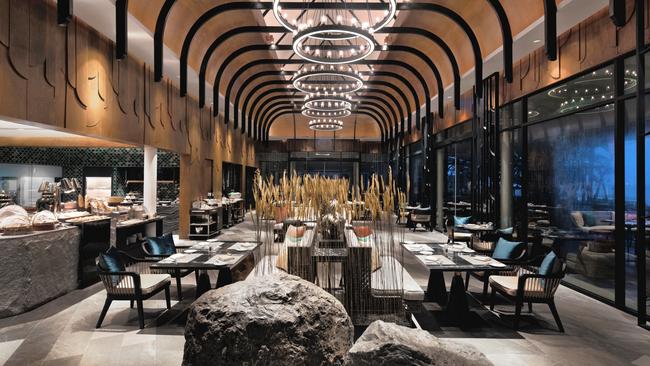
Dr Shanbagh has been brought in from Bangalore to create a “coherent’’ health program for the resort incorporating everything from diet and meditation to breathwork and forest bathing. His philosophy focuses on the important things in life, such as sleep and rest, “harmony with nature” and physical vitality. So the potential’s here to have an incredibly healthy holiday. But, equally, if excess and indulgence is your preferred vacation vibe, Banyan Tree Krabi caters to that too.
Signature restaurant Saffron is perched on a hillside accessible by steep staircase (not ideal in the heat) or a short funicular (perfect). Interiors of glossy timber and glass face sea and forest but, given Saffron is open only for dinner, there’s not much to admire. Except the food. The menu runs to crisp Thai omelettes (kai jiew) with Andaman crab meat, wok-fried pork belly with butter beans and shrimp paste, betel leaf ice cream and a rum cocktail crafted to taste like mango sticky rice.
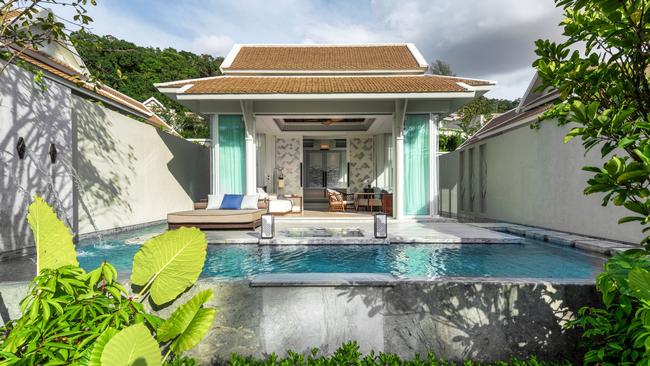
All-day eatery Naga Kitchen serves Western and Thai dishes, including an unforgettably fiery snail curry, and one of the most comprehensive breakfast buffets I’ve encountered in my career. Highlights are the house-baked French pastries, DIY Bloody Marys, an ice-cream fridge, and street-food trolleys where villagers come in and cook local snacks.
From Krabi I head north by direct flight to Chiang Mai, the 13th-century capital hemmed by mountains. It’s my first visit but the place appeals immediately with its remnant walls and moat-like canals marking the limits of the ancient city, once the exclusive home of kings and monks. The Melia Chiang Mai takes longer to warm to, but I get there eventually. This 22-storey skyscraper, and seven-floor podium tower, initially feels out of place among the old town and sea of temple stupas. In fact it has stood here since the 1970s as the Pornping Tower Hotel. The location is ideal for tourists; it’s a few minutes’ stroll to the famous Chiang Mai night bazaar with its food, souvenirs and, since cannabis was legalised in June, marijuana merchants.
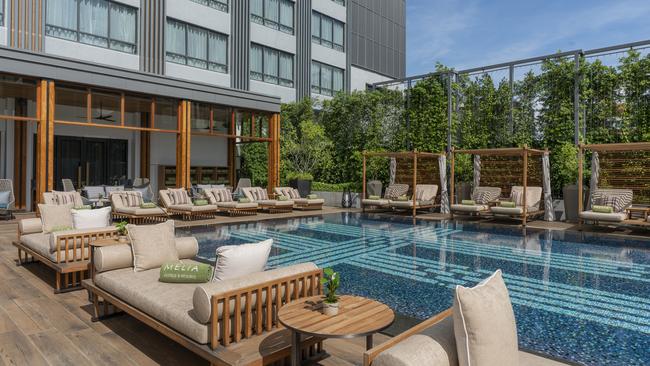
New Spanish owner Melia has given the old girl a thorough makeover, with resort-style pool, impeccably equipped kids’ club and stylised interiors featuring local motifs and materials – lanterns, weavings, wicker and silks – to try to make it fit in. I’m told Standard Melia rooms are 30sq m, with king bed, compact bathroom and window seat, but they feel smaller. Perhaps that’s just the contrast with my sprawling pool villa at Krabi. After inspecting other room types, I’d recommend booking at least a 44sq m premium room, which has a walk-in wardrobe and decent-sized bathroom. Better still, light-filled corner rooms in the podium building are almost double the size of standard rooms.
Fusion’s not always a good idea, and my jury’s still out on Melia’s decision to offer Spanish-themed eateries and bars. Breakfasts at all-day Laan Naa restaurant offer the unusual contrast of noodles, curries and congees alongside tortillas and chocolate churros. At the striking rooftop bar, which looks east over the Ping River and west to the Doi Thep mountains, Thai staff have adopted Hispanic names, the music’s Latin and the cocktails have names like El Rio Ping, a fruity blend of rum, cherry brandy and coconut cream. But on the floor below at Mai restaurant there’s plenty of authenticity. Chef Billy prepares northern Thai-inspired menus that begin with snacks – puffed rice and creamy crab, minced pork wrapped in purple pea flower – and segue into richly smoky fish soup and baked salmon with nham prik ong, the spicy pork and tomato dip.
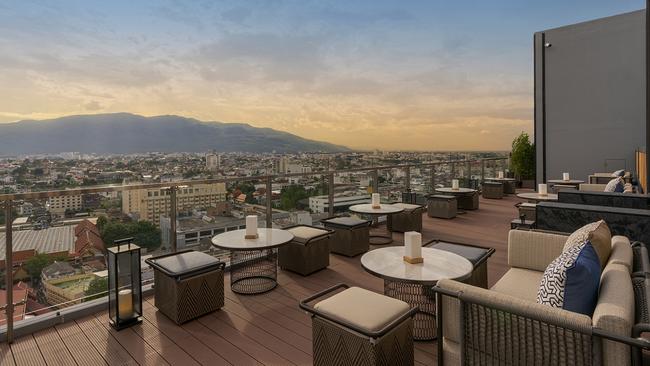
Beside Mai is The Level, Melia’s high-rise club lounge. It offers the usual executive perks – breakfast, all-day snacks and drinks, including generous evening cocktails – but distinguishes itself with exceptional service. Manager George was poached from the neighbouring Shangri-La, and I meet one Australian couple who’ve switched to Melia purely because of him. They’ve become good friends and the couple regale George daily with tales of their exploits, including para-motoring above the city.
The staff are a strength here, from concierge Mike to my therapist in the seven-room subterranean spa who hammers my body with a wooden mallet and stake. I feel like a child’s toy but the rhythm of this odd but apparently timeworn “toksen” technique releases my muscles, like clearing traffic jams in my body.
Mike organises a city tour for me with veteran guide Thongpoon Yakala and it is excellent. We start at Brewginning Coffee, formerly a rattan shop, where cool young staff serve chill music and great espresso. Lunch is at Lamduan Fa Ham, the most famous khao soi joint in Chiang Mai. The yellow noodle curry – chicken or beef – arrives piping hot from the street-facing kitchen. After we’ve seasoned our bowls with fresh lime, onion, pickle, chilli and various sauces, Yakala explains how he survived the Covid shutdown by working as an electrician and breeding fancy chickens to sell. “You’re only my second customer since the pandemic began,” he says softly.
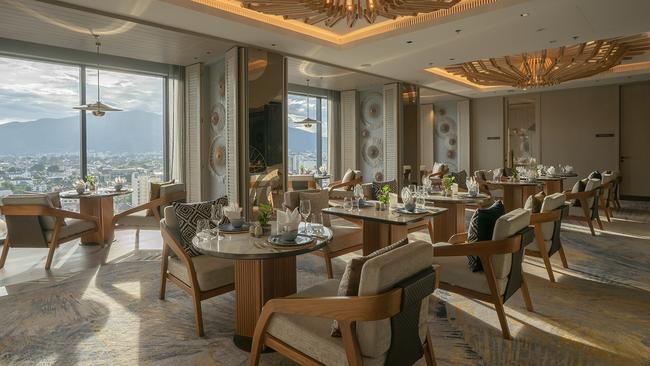
Afterwards we drive into the hills to Doi Suthep mountain. The temple here, which Yakala says contains the relics and ashes from Lord Buddha’s shoulders, is a significant pilgrimage site. (The relics, sealed in bricks and covered in bronze, are not for public show.) Real pilgrims slog up the 306 steps to the temple complex; we pay a small fee to take the funicular instead.
The pagoda has been progressively gilded with gold leaf since the 14th century. Today it gleams like the sun. Worshippers buy lotus flowers then circle the stupa three times, once for the Buddha, once for the religion (dharma) and once for the monks (samgha). Others write their names on bells strung from temple verandas, and leave gifts for the monks – robes, rice cookers, food – to give thanks or seek divine favours.
At Baan Kang Wat, “House Beside Temple”, we wander through a bohemian village fair on the city’s western edge. Its stalls consist mainly of traditional teak houses converted into artist studios, cafes, and boutiques selling vintage clothes and sneakers, ice cream, coffee and art. Normally this place would be packed with Chinese tourists, Yakala says, but they haven’t returned yet. On the drive back to the hotel, he points out two major shopping centres that have closed recently due to lack of custom.
With tourism in Thailand still regaining strength, it feels as though we’re more welcome than ever. I’d forgotten just how warm and funny the Thais are, perhaps even more so now after being starved of foreign visitors for years. They seem delighted we’re back. The feeling’s mutual.
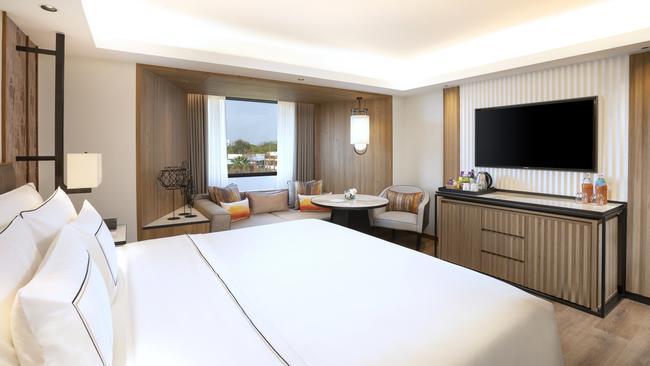
In the know
Rooms at Banyan Tree Krabi from $690 a night, including buffet breakfast (transfers from Krabi or Phuket airports extra). Rates at the Melia Chiang Mai from about $195 with breakfast.
Jetstar flies direct to Phuket or Bangkok from east-coast capitals.
Kendall Hill was a guest of Banyan Tree Krabi, Melia Chiang Mai and Jetstar.





To join the conversation, please log in. Don't have an account? Register
Join the conversation, you are commenting as Logout